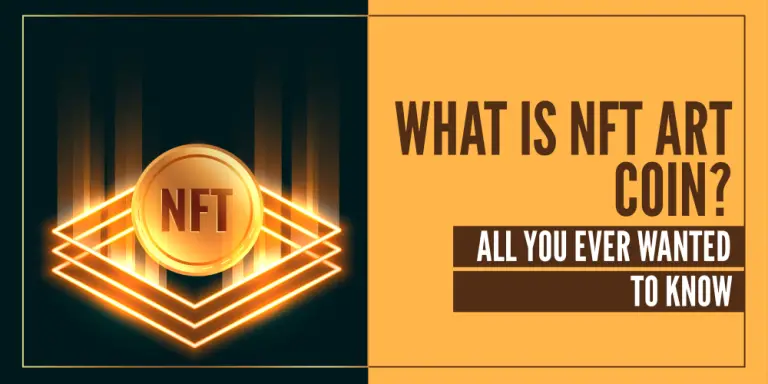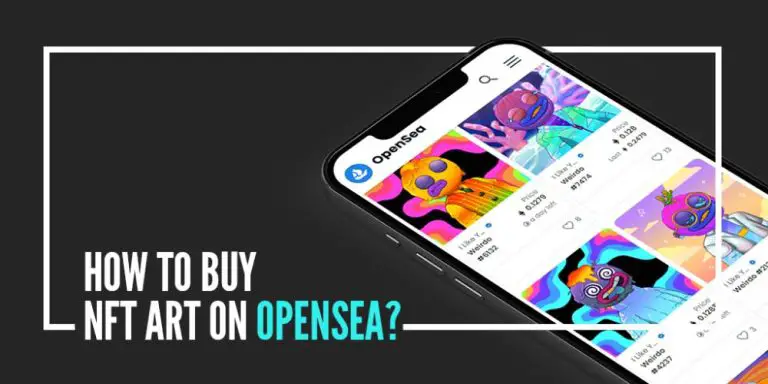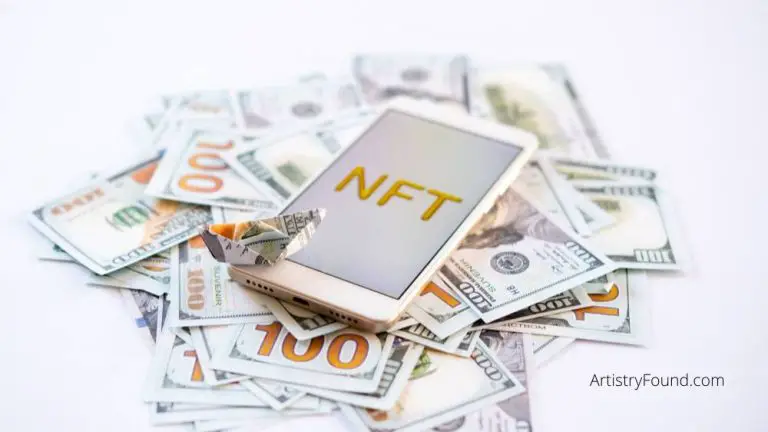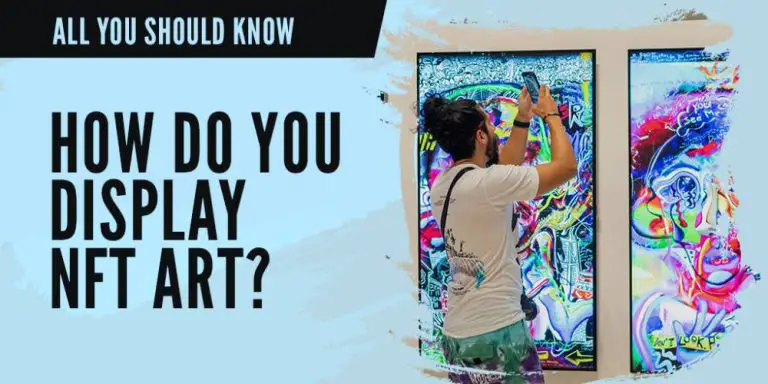How To Make Generative Art NFT (What You Need to Know)
The craze of generative art NFT is huge these days. NFT art is all about abstract pieces of digital art that are traded for hundreds of thousands of US dollars.

(This article may contain affiliate links and I may earn a commission if you make a purchase)
https://www.rawpixel.com/image/3196186/free-illustration-image-iot-blockchain-iot-banking
The sale of nonfungible tokens (NFTs) has reached $25 billion in 2021, and with this, the sector demonstrated that it is one of the most sought-after markets in cryptocurrency. Art NFTs, in particular, has made a huge impact lately.
The crypto art scene is dominated mainly by cartoons and memes and, in a way, is acting as a generative art NFT repository.
Generative NFTs are evolving into a very popular art form within the art community. Alongside them are emerging technologies like artificial intelligence, blockchain, Metaverse, etc.
If you are wondering how to make generative art NFT, the answer is you have to use generative adversarial networks or GANs. Machine-created art is created by using generative adversarial networks, which leverage computers to utilize data.
But, before describing how to make generative art NFT, we should explain what exactly is NFT and generative art NFT, and what this trend means for the art market.
What Is NFT?

NFT stands for non-fungible token, and it is an interchangeable data unit that is stored on a blockchain. It works like a digital ledger, and it can be bought, sold, and traded.
NFT files are associated with digital files like images, videos, and audio. NFTs are different than other cryptocurrencies because they are non-fungible, which means their value cannot be replaced by anything else.
These non-fungible tokens work like the usual cryptographic tokens other than the fact that they are not mutually interchangeable. While all Bitcoins are the same, and the value of one bitcoin equals the value of another bitcoin, that is not the case with NFTs.
The non-fungible token is created once a blockchain concatenates records containing a cryptographic set of characters.
However, there is one huge problem with NFTs. They do not restrict the sharing or copying of the underlying digital files. Also, they do not necessarily convey the copyright of the digital files.
When it comes to ownership of NFTs, that does not necessarily mean copyright. An artist’s NFT does not automatically give the buyer the right to resell it as their own. However, in the event of the seller creating additional NFTs of the same work, they are free to do so. In the end, just owning an NFT is not proof that you have copyright.
NFT platforms that sell these nonfungible tokens usually charge the artists fees for minting, listing, and claiming. Some analysis of the market in 2021 found that most artworks were selling for less than $200, while a third of them were selling for less than $100. The ones that were selling for less than $100 were paying the highest fees. Artists have to pay fees between 72 and 150% of the price.
Another interesting fact about NFTs is that they come with high energy costs. Although they are very popular, NFTs have raised a lot of negative feelings about their energy costs and carbon footprints. On one occasion, the NFT market was compared with a Ponzi scheme.
What Is Generative Art NFT?
Generative art is a very common expression in the NFT world. Essentially, NFTs are the new way of owning a piece of art. The term indicates artworks that have gone through a generation process by a system that is set into motion to autonomically create a complete work of art.
In other words, generative art is a partnership between the artist and an autonomous computer system.
NFT art is a rapidly growing system within the crypto world. This movement fundamentally challenges the concept of art and its value.
The Scrappy Squirrels project
The NFTs in Scrappy Squirrels are randomly generated on the Ethereum Blockchain. NFT artists, developers, and first-time customers are all targeted with this project.
Scrappy Squirrels is a supportive and enthusiastic community that aims to educate people about the exciting applications of NFTs. In addition to offering a great way for newcomers to experience this revolutionary technology, Scrappy Squirrels offers a great entry point into the world of NFTs.
The Rise Of NFT Art
NFT creators are using artificial intelligence art and algorithms in such a way that they can address issues of mercurial valuation. Al generative platforms create and store digital content and exciting projects all on the Ethereum blockchain.
Then, art collectors can pick what they like, pay for the artwork using cryptocurrencies, and order a randomly generated version of the content. That content is created by an algorithm and then sent to the collector’s Ethereum address.
A very early example of generative art is Mozart’s “Musikalisches Würfelspiel,” which was published in the late eighteenth century. This was a piece of art that was created in traditional manners.
However, today, blockchain technology enables different kinds of artistic creation. Generic art can be created by running a code (known as a smart contract) that is kept on a blockchain under a specific address, mostly on Ethereum.
The smart contract is triggered by sending crypto (mostly ETH) to this address, and then the code will be executed automatically.
Alongside blockchain technology, NFTs are evolving in a way that a generative art can currently be designed by a smart contract and be held on-chain as NFT. That NFT will be directly owned by the wallet address that sends crypto to run the smart contract.
One common process of creating generative art is through a machine algorithm. That doesn’t necessarily mean that every generative art created through an algorithm will be an NFT.
To have an NFT out of a generative Art, you need to include inputs such as wallet address or transaction ID. After adding these parameters, you can start minting the NFT.
The main question here is how will the created NFT be something special if the same algorithm can be run millions of times?
The key is to the added supply cap that can be implemented right from the beginning. This supply cap is the advantage of NFT generative art. Only a certain and predefined amount of NFTs that follow the same algorithmic rules can be created.
After we’ve cleared up what generative art is, let’s talk about how to make generative art NFT.
How To Make Generative NFT Art
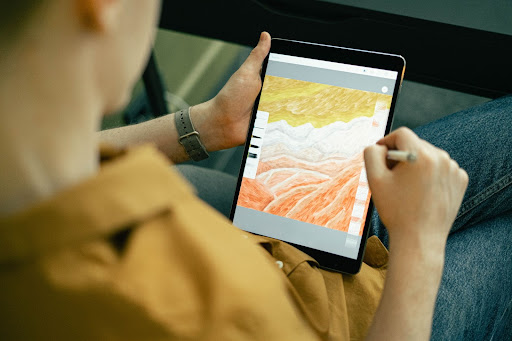
https://www.pexels.com/photo/person-drawing-on-a-tablet-4238489/
Making NFT art is a great way to get involved in the flourishing NFT ecosystem. Unlike traditional art forms, NFT art gives creators complete control over how their work is distributed and discovered. Additionally, multiple images can be grouped together to create a single work of art, providing more flexibility and opportunity for experimentation.
To get started, all you need is an image or multiple images that you would like to convert into an NFT. Once your images are ready, you can use a service like Ethereum to create your NFT and mint it onto the blockchain or put it on the Open Sea platform.
From there, you can upload and start sharing your NFT art with the world and get on board with the NFT revolution. Who knows, you might just evolve into the next big deal in the world of digital art.
Step 1: Create a Unique Image
The first step of our guide is the hardest one because it requires creating a unique piece of art in the NFT space. If you don’t know how to create a one-of-a-kind image, you won’t have anything to sell.
So, we recommend sparing some time to create an awesome art piece or spending some money to find a good illustrator.
It can be a graphic designer or maybe a traditional illustrator who creates awesome hand-drawn art. Either way, make sure it follows the theme and sense of style you have in mind for the output.
Step 2: Digital Package
This step is all about the final preparations of the image before it is generated and rendered. In an ideal case, the artist himself should do this, but it can also be done by the digital artist.
Current use cases dictate that the perfect size of generative art NFTs is 600×600 pixels, with a transparent background.
Our recommendation is to use Adobe Photoshop for this step. In the base layer, place the base character image. Above the base layer, add layer groups for each of the attributes, such as the face, clothes, accessories, etc. Inside each group, you have to create the artwork for each attribute. For example, in the clothes group, create a separate layer for every piece, hat, t-shirt, jacket, pants, etc.
After you’ve done all of this, switch the base layer on to make sure all attributes sit well on the base image.
Step 3: Make Sure The Layer Order Is Right
The third step is very critical in this whole process. Make sure that each layer you created in Adobe Photoshop (or any other free, open-source GIMP graphics package) is in its exact position. This way, you will prevent problems when it is time to generate your image.
You need to switch the attribute groups on and off to see whether there is a conflict between the layers. The hat should be on top of the head, and the button should be on top of the shirt, right?
If you have attributes that interfere with each other; for example, a mouth and a tobacco pipe, then you have to be certain that the mouth is not placed on top of the pipe and that one does not interfere with the other. If you find problems, you have to make adjustments.
You must make this type of adjustment before you start generating and rendering a hundred images.
Once you are done with the order of the layers, the creative part is done. It is time to transfer the file to a generative programmer.
Step 4: Preparing For Generative Programming
There is another essential person who needs to be involved in this whole process, and that is the generative programmer.
Although the graphic designer is the key component in our guide on how to make generative art NFT, you won’t have an NFT if you don’t have a good programmer.
The first thing that the programmer needs to do is to validate all of the art layers. He needs to make sure that the layers do not conflict with one another and that they are stable.
Although the programmer shouldn’t apply any creative attributes in this process, he might have to make minor adjustments in some cases.
Following this, the programmer has to set up a folder structure. This structure needs to reflect all layers that had been defined in the art file. He needs to output the base layer, all the attribute layers, and their defined variations of colors, textures, shapes, etc., into transparent PNG files and place them in the correct folder location.
In some cases, this step may result in 500 different transparency files placed in multiple folders and subfolders.
Step 5: The Actual Programming
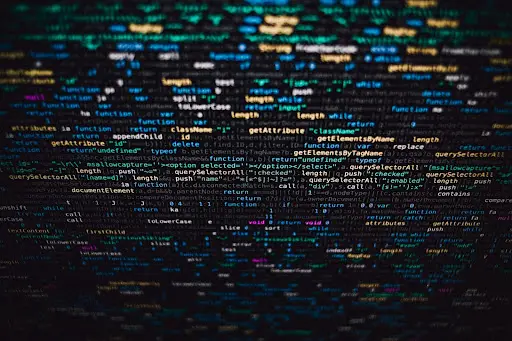
https://www.rawpixel.com/image/593171/programmer-code-screen
Generative programming begins with creating a dataset of all the attributes. Alongside the attributes, the programmer has to create a dataset of all variations and levels as well.
After all, once datasets are done, the programmer has to do a test run. To achieve this, you will have to use a generative programming system.
In many situations, you may need to add additional complex features like a unique name generator, which will give your image a unique number and a unique name. All of this will be burned into the final render.
This step is also about finding mistakes. We should look for errors in the transparency files, in the datasets, or possible conflicts in the attributes.
The perfect loop is this: run a test, make corrections, run the test again, and follow the steps until there are no mistakes.
Step 6: Rendering
After all the tests, checks, and approvals, it is time to do a final run. The final run represents the rendering of the images.
We recommend that this is done in batches of 100 at a time. This way, if there are any anomalies, you can catch them right away. After the rendering, the images are ready to be uploaded and minted.
Step 7: List and Mint
The hard part is already done. What is left to do is a list and minting the NFTs on the market. You can choose any cryptocurrency you prefer.
You need to be cautious when choosing to mint and while selecting your currency as well. You don’t want to spend a huge amount of money on gas fees.
Our choice would be Ethereum blockchain because it reduces gas fees to a negligible amount. Nonetheless, there are a lot of other platforms and cryptocurrencies on which you can list and mint your NFT art.
How To Make Generative Art NFT – Conclusion
The seven step-list about “how to make generative art NFT” starts with the creative process.
You have to keep your imagination running wild and create a unique, one-of-a-kind piece. After you find the right idea and the perfect image, you get to choose editing software to create your masterpiece.
Always have in mind that you have to keep your layers of data in the perfect order and add as many details as you can.
After the creative process, generative programming comes into play. This is a tricky process of generating algorithms that will eventually render the image into many transparent PNG files.
At the end of the process, you’ll need to run multiple tests to make sure that everything is in order.
If you follow the steps on “how to make generative art NFT” and pay close attention to the details, you will have your little masterpiece ready for selling in no time.

